Strategic Agility Report: Analysis for Oak Tree Inn's Future
VerifiedAdded on 2022/12/15
|10
|2728
|448
Report
AI Summary
This report provides a comprehensive strategic agility analysis for the Oak Tree Inn, a UK-based hospitality business. It begins with an introduction to strategic agility and its importance, referencing McKinsey & Company's framework. The report then delves into external and internal analyses. The PESTLE analysis examines political, economic, social, technological, legal, and environmental factors affecting the business. Porter's Five Forces model evaluates the competitive landscape, including buyer power, supplier power, threat of new entrants, threat of substitutes, and industry rivalry. A SWOT analysis assesses the inn's strengths, weaknesses, opportunities, and threats. The report then evaluates strategic choices using the SAFe analysis, assessing the suitability, accessibility, and feasibility of the proposed strategies. The conclusion summarizes the key findings and recommendations for the Oak Tree Inn to enhance its strategic agility and achieve its goals.
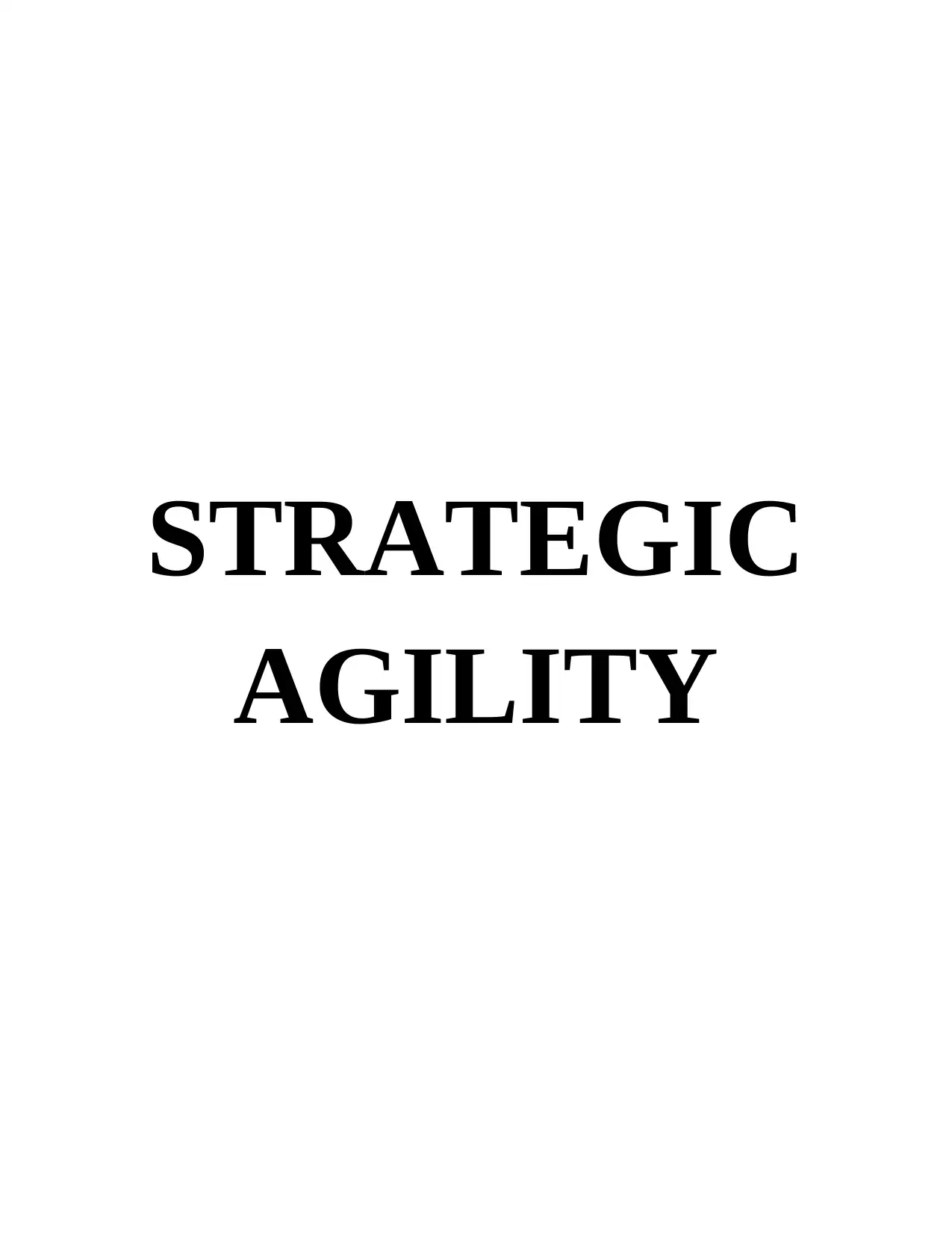
STRATEGIC
AGILITY
AGILITY
Paraphrase This Document
Need a fresh take? Get an instant paraphrase of this document with our AI Paraphraser
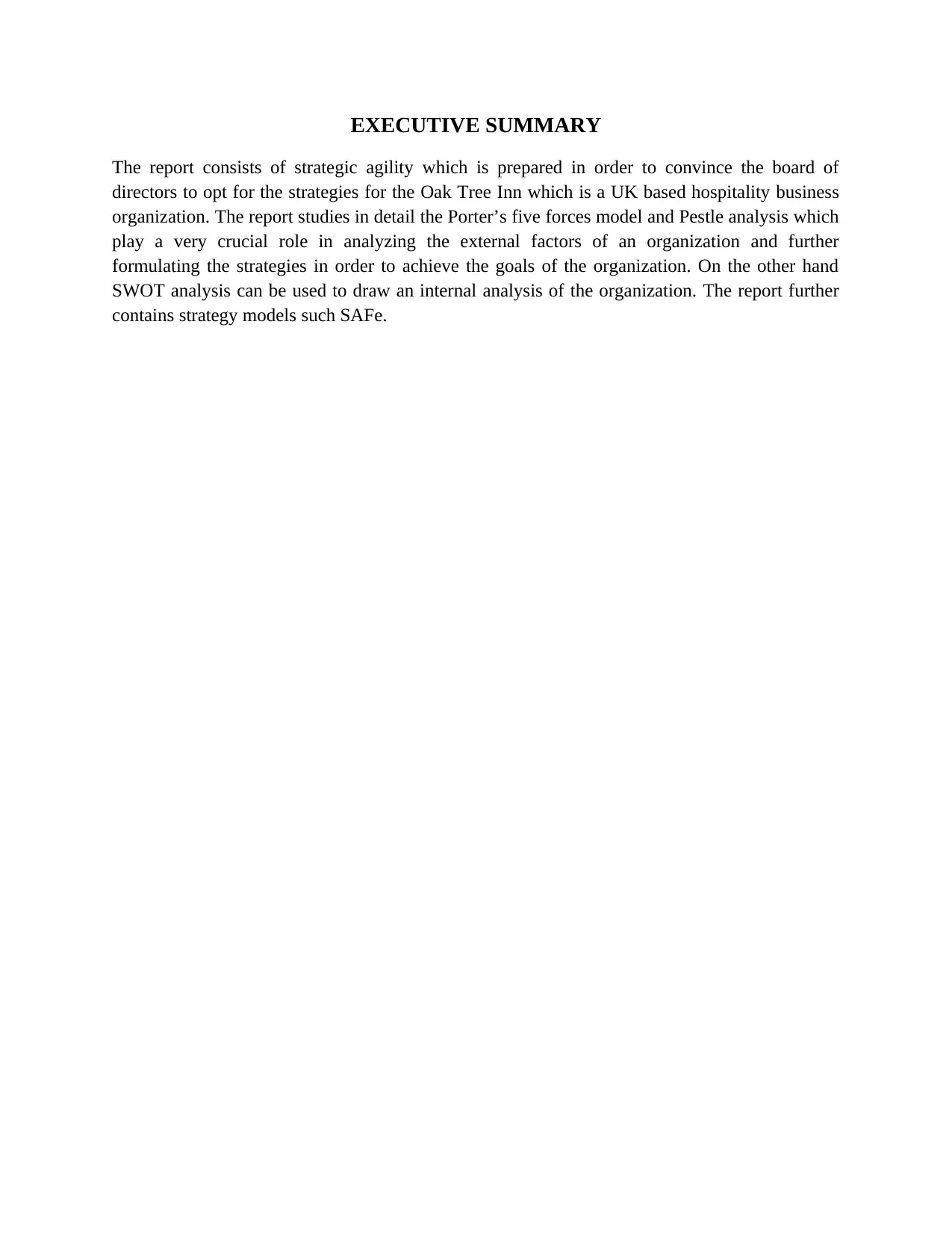
EXECUTIVE SUMMARY
The report consists of strategic agility which is prepared in order to convince the board of
directors to opt for the strategies for the Oak Tree Inn which is a UK based hospitality business
organization. The report studies in detail the Porter’s five forces model and Pestle analysis which
play a very crucial role in analyzing the external factors of an organization and further
formulating the strategies in order to achieve the goals of the organization. On the other hand
SWOT analysis can be used to draw an internal analysis of the organization. The report further
contains strategy models such SAFe.
The report consists of strategic agility which is prepared in order to convince the board of
directors to opt for the strategies for the Oak Tree Inn which is a UK based hospitality business
organization. The report studies in detail the Porter’s five forces model and Pestle analysis which
play a very crucial role in analyzing the external factors of an organization and further
formulating the strategies in order to achieve the goals of the organization. On the other hand
SWOT analysis can be used to draw an internal analysis of the organization. The report further
contains strategy models such SAFe.
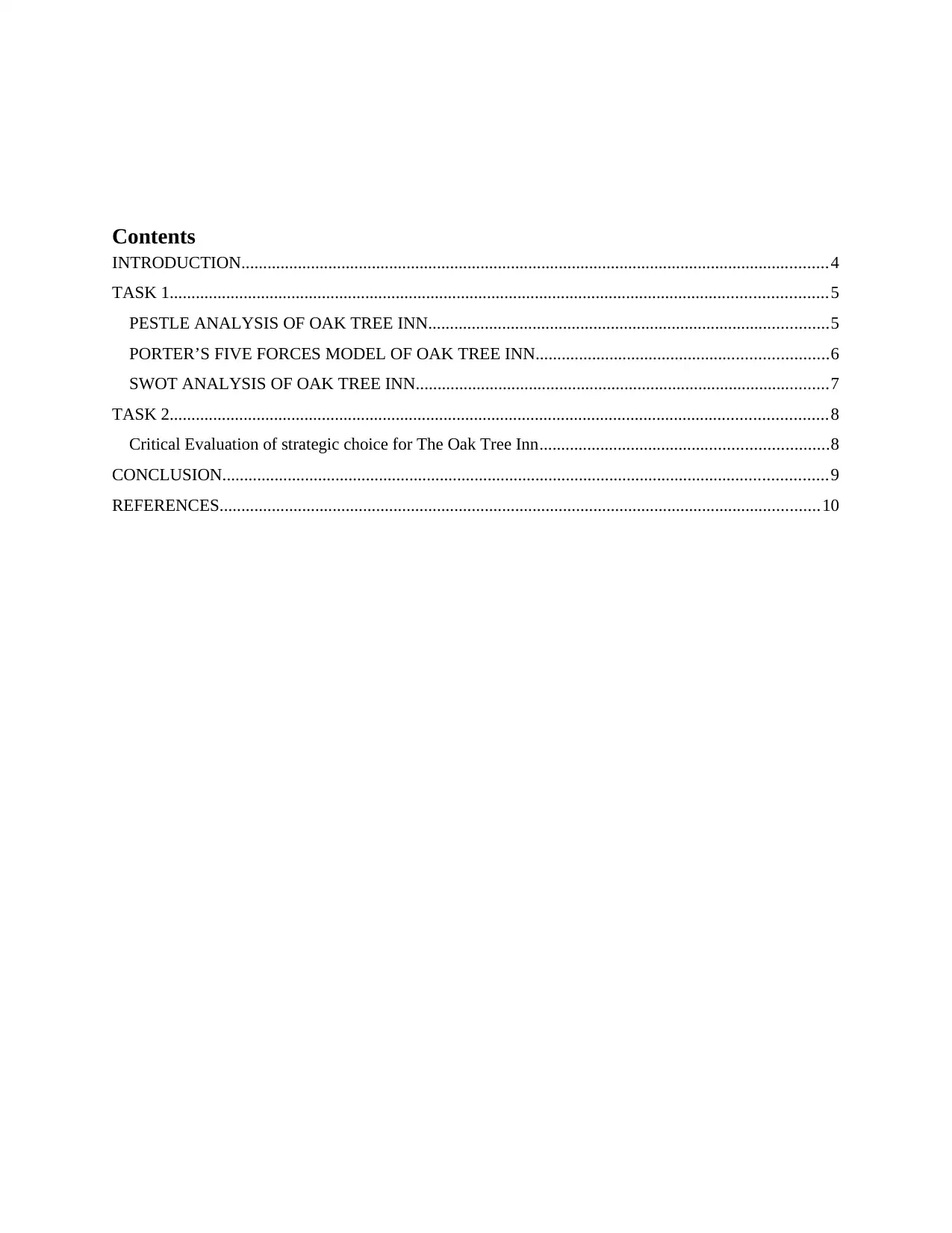
Contents
INTRODUCTION.......................................................................................................................................4
TASK 1.......................................................................................................................................................5
PESTLE ANALYSIS OF OAK TREE INN............................................................................................5
PORTER’S FIVE FORCES MODEL OF OAK TREE INN...................................................................6
SWOT ANALYSIS OF OAK TREE INN...............................................................................................7
TASK 2.......................................................................................................................................................8
Critical Evaluation of strategic choice for The Oak Tree Inn..................................................................8
CONCLUSION...........................................................................................................................................9
REFERENCES..........................................................................................................................................10
INTRODUCTION.......................................................................................................................................4
TASK 1.......................................................................................................................................................5
PESTLE ANALYSIS OF OAK TREE INN............................................................................................5
PORTER’S FIVE FORCES MODEL OF OAK TREE INN...................................................................6
SWOT ANALYSIS OF OAK TREE INN...............................................................................................7
TASK 2.......................................................................................................................................................8
Critical Evaluation of strategic choice for The Oak Tree Inn..................................................................8
CONCLUSION...........................................................................................................................................9
REFERENCES..........................................................................................................................................10
⊘ This is a preview!⊘
Do you want full access?
Subscribe today to unlock all pages.

Trusted by 1+ million students worldwide
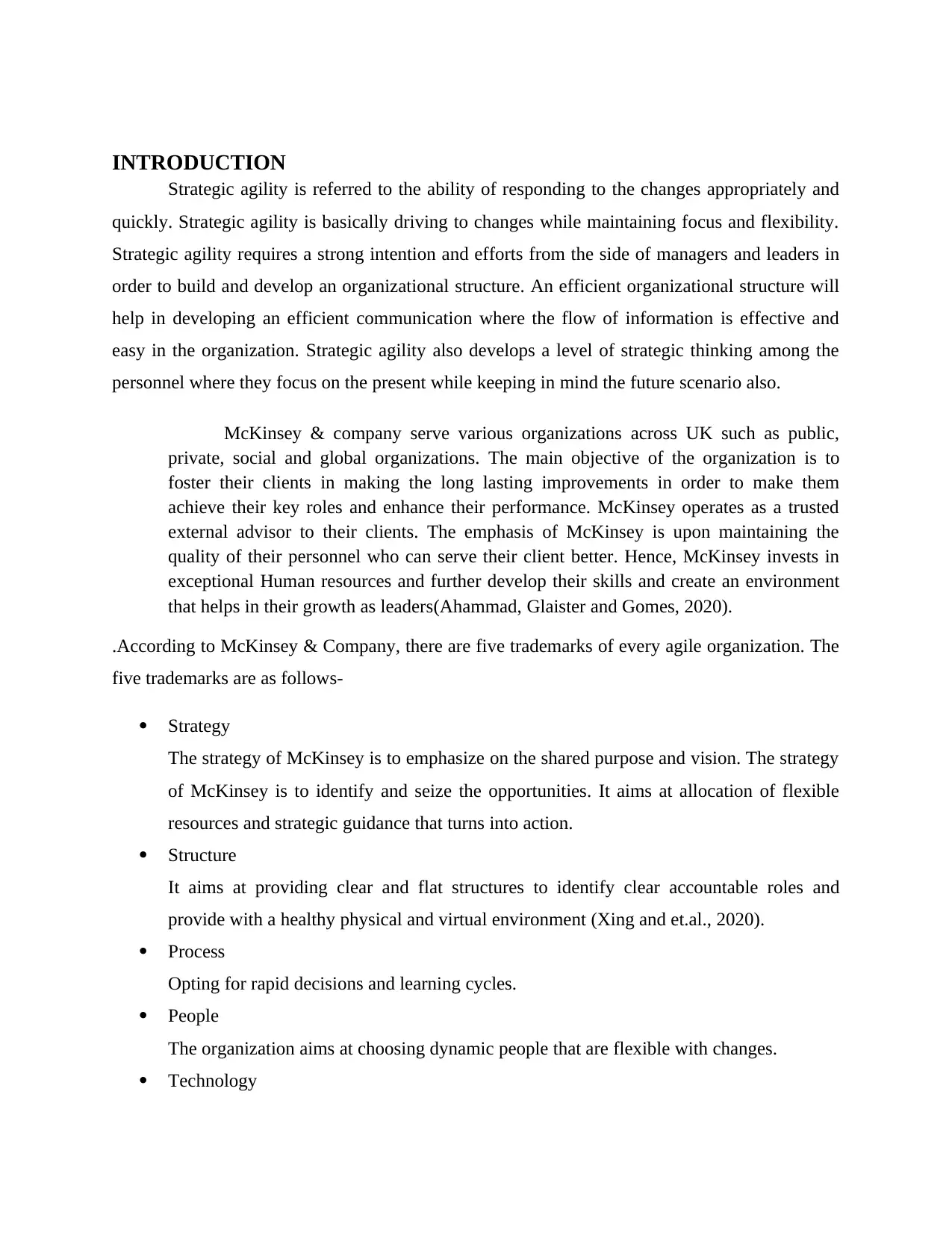
INTRODUCTION
Strategic agility is referred to the ability of responding to the changes appropriately and
quickly. Strategic agility is basically driving to changes while maintaining focus and flexibility.
Strategic agility requires a strong intention and efforts from the side of managers and leaders in
order to build and develop an organizational structure. An efficient organizational structure will
help in developing an efficient communication where the flow of information is effective and
easy in the organization. Strategic agility also develops a level of strategic thinking among the
personnel where they focus on the present while keeping in mind the future scenario also.
McKinsey & company serve various organizations across UK such as public,
private, social and global organizations. The main objective of the organization is to
foster their clients in making the long lasting improvements in order to make them
achieve their key roles and enhance their performance. McKinsey operates as a trusted
external advisor to their clients. The emphasis of McKinsey is upon maintaining the
quality of their personnel who can serve their client better. Hence, McKinsey invests in
exceptional Human resources and further develop their skills and create an environment
that helps in their growth as leaders(Ahammad, Glaister and Gomes, 2020).
.According to McKinsey & Company, there are five trademarks of every agile organization. The
five trademarks are as follows-
Strategy
The strategy of McKinsey is to emphasize on the shared purpose and vision. The strategy
of McKinsey is to identify and seize the opportunities. It aims at allocation of flexible
resources and strategic guidance that turns into action.
Structure
It aims at providing clear and flat structures to identify clear accountable roles and
provide with a healthy physical and virtual environment (Xing and et.al., 2020).
Process
Opting for rapid decisions and learning cycles.
People
The organization aims at choosing dynamic people that are flexible with changes.
Technology
Strategic agility is referred to the ability of responding to the changes appropriately and
quickly. Strategic agility is basically driving to changes while maintaining focus and flexibility.
Strategic agility requires a strong intention and efforts from the side of managers and leaders in
order to build and develop an organizational structure. An efficient organizational structure will
help in developing an efficient communication where the flow of information is effective and
easy in the organization. Strategic agility also develops a level of strategic thinking among the
personnel where they focus on the present while keeping in mind the future scenario also.
McKinsey & company serve various organizations across UK such as public,
private, social and global organizations. The main objective of the organization is to
foster their clients in making the long lasting improvements in order to make them
achieve their key roles and enhance their performance. McKinsey operates as a trusted
external advisor to their clients. The emphasis of McKinsey is upon maintaining the
quality of their personnel who can serve their client better. Hence, McKinsey invests in
exceptional Human resources and further develop their skills and create an environment
that helps in their growth as leaders(Ahammad, Glaister and Gomes, 2020).
.According to McKinsey & Company, there are five trademarks of every agile organization. The
five trademarks are as follows-
Strategy
The strategy of McKinsey is to emphasize on the shared purpose and vision. The strategy
of McKinsey is to identify and seize the opportunities. It aims at allocation of flexible
resources and strategic guidance that turns into action.
Structure
It aims at providing clear and flat structures to identify clear accountable roles and
provide with a healthy physical and virtual environment (Xing and et.al., 2020).
Process
Opting for rapid decisions and learning cycles.
People
The organization aims at choosing dynamic people that are flexible with changes.
Technology
Paraphrase This Document
Need a fresh take? Get an instant paraphrase of this document with our AI Paraphraser
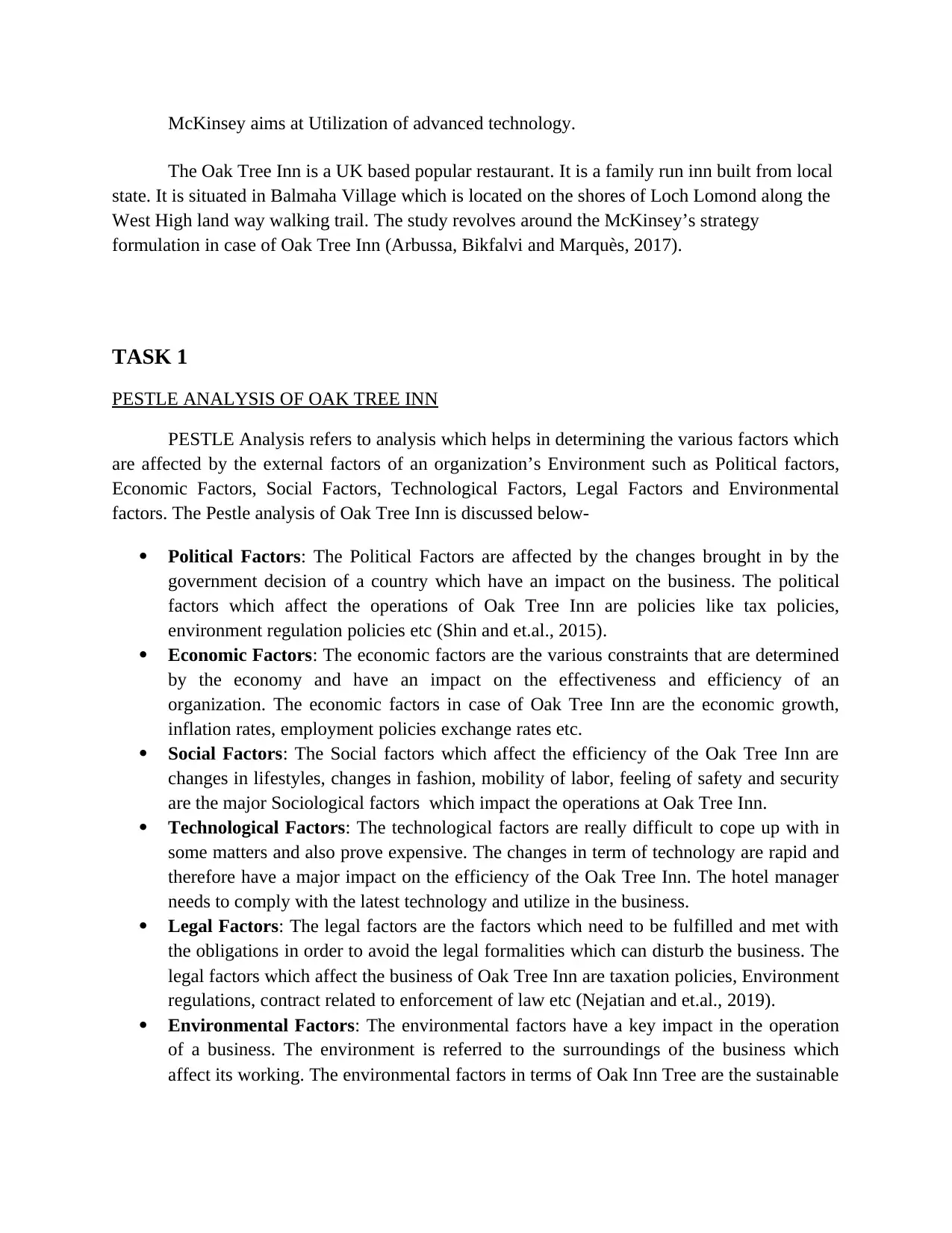
McKinsey aims at Utilization of advanced technology.
The Oak Tree Inn is a UK based popular restaurant. It is a family run inn built from local
state. It is situated in Balmaha Village which is located on the shores of Loch Lomond along the
West High land way walking trail. The study revolves around the McKinsey’s strategy
formulation in case of Oak Tree Inn (Arbussa, Bikfalvi and Marquès, 2017).
TASK 1
PESTLE ANALYSIS OF OAK TREE INN
PESTLE Analysis refers to analysis which helps in determining the various factors which
are affected by the external factors of an organization’s Environment such as Political factors,
Economic Factors, Social Factors, Technological Factors, Legal Factors and Environmental
factors. The Pestle analysis of Oak Tree Inn is discussed below-
Political Factors: The Political Factors are affected by the changes brought in by the
government decision of a country which have an impact on the business. The political
factors which affect the operations of Oak Tree Inn are policies like tax policies,
environment regulation policies etc (Shin and et.al., 2015).
Economic Factors: The economic factors are the various constraints that are determined
by the economy and have an impact on the effectiveness and efficiency of an
organization. The economic factors in case of Oak Tree Inn are the economic growth,
inflation rates, employment policies exchange rates etc.
Social Factors: The Social factors which affect the efficiency of the Oak Tree Inn are
changes in lifestyles, changes in fashion, mobility of labor, feeling of safety and security
are the major Sociological factors which impact the operations at Oak Tree Inn.
Technological Factors: The technological factors are really difficult to cope up with in
some matters and also prove expensive. The changes in term of technology are rapid and
therefore have a major impact on the efficiency of the Oak Tree Inn. The hotel manager
needs to comply with the latest technology and utilize in the business.
Legal Factors: The legal factors are the factors which need to be fulfilled and met with
the obligations in order to avoid the legal formalities which can disturb the business. The
legal factors which affect the business of Oak Tree Inn are taxation policies, Environment
regulations, contract related to enforcement of law etc (Nejatian and et.al., 2019).
Environmental Factors: The environmental factors have a key impact in the operation
of a business. The environment is referred to the surroundings of the business which
affect its working. The environmental factors in terms of Oak Inn Tree are the sustainable
The Oak Tree Inn is a UK based popular restaurant. It is a family run inn built from local
state. It is situated in Balmaha Village which is located on the shores of Loch Lomond along the
West High land way walking trail. The study revolves around the McKinsey’s strategy
formulation in case of Oak Tree Inn (Arbussa, Bikfalvi and Marquès, 2017).
TASK 1
PESTLE ANALYSIS OF OAK TREE INN
PESTLE Analysis refers to analysis which helps in determining the various factors which
are affected by the external factors of an organization’s Environment such as Political factors,
Economic Factors, Social Factors, Technological Factors, Legal Factors and Environmental
factors. The Pestle analysis of Oak Tree Inn is discussed below-
Political Factors: The Political Factors are affected by the changes brought in by the
government decision of a country which have an impact on the business. The political
factors which affect the operations of Oak Tree Inn are policies like tax policies,
environment regulation policies etc (Shin and et.al., 2015).
Economic Factors: The economic factors are the various constraints that are determined
by the economy and have an impact on the effectiveness and efficiency of an
organization. The economic factors in case of Oak Tree Inn are the economic growth,
inflation rates, employment policies exchange rates etc.
Social Factors: The Social factors which affect the efficiency of the Oak Tree Inn are
changes in lifestyles, changes in fashion, mobility of labor, feeling of safety and security
are the major Sociological factors which impact the operations at Oak Tree Inn.
Technological Factors: The technological factors are really difficult to cope up with in
some matters and also prove expensive. The changes in term of technology are rapid and
therefore have a major impact on the efficiency of the Oak Tree Inn. The hotel manager
needs to comply with the latest technology and utilize in the business.
Legal Factors: The legal factors are the factors which need to be fulfilled and met with
the obligations in order to avoid the legal formalities which can disturb the business. The
legal factors which affect the business of Oak Tree Inn are taxation policies, Environment
regulations, contract related to enforcement of law etc (Nejatian and et.al., 2019).
Environmental Factors: The environmental factors have a key impact in the operation
of a business. The environment is referred to the surroundings of the business which
affect its working. The environmental factors in terms of Oak Inn Tree are the sustainable
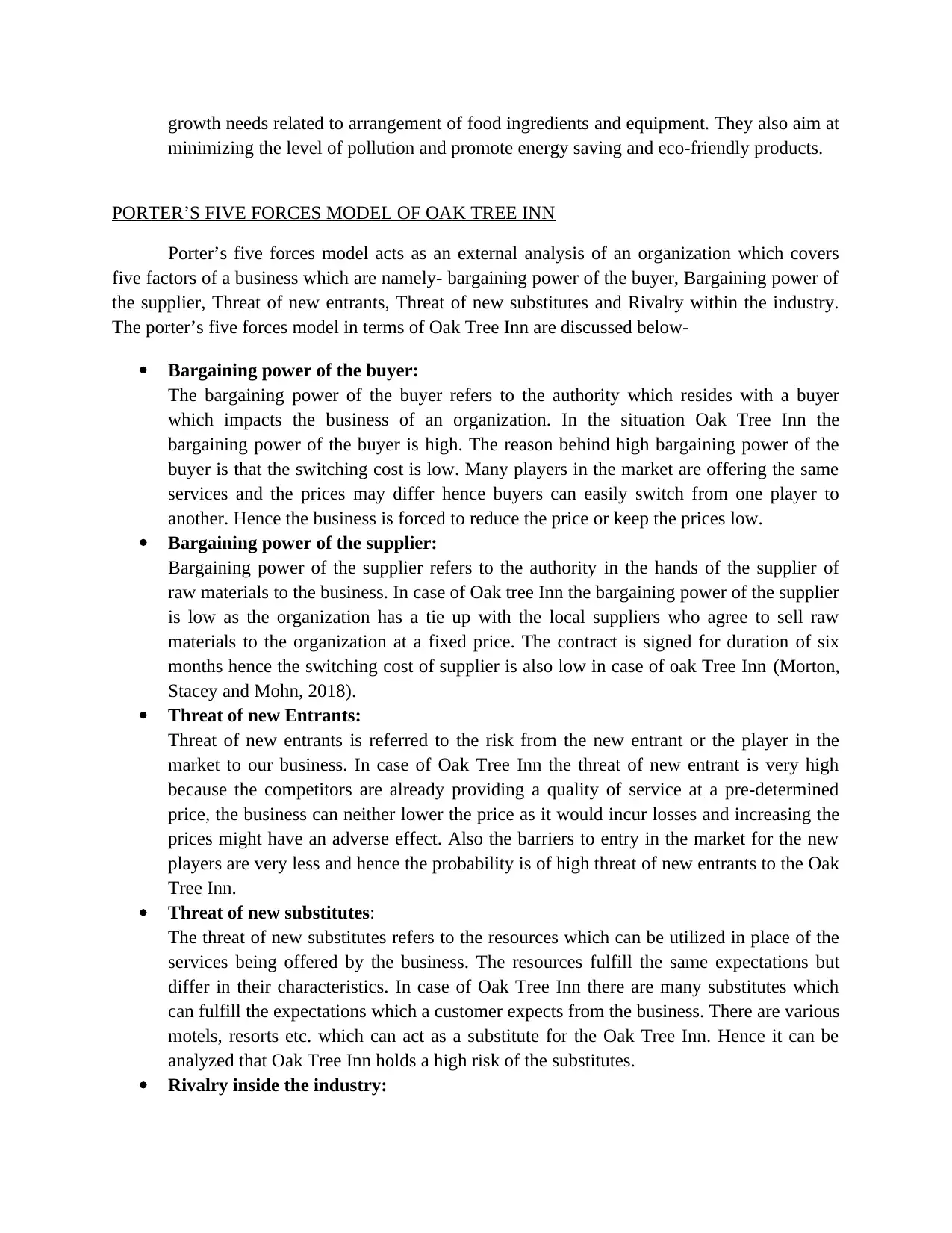
growth needs related to arrangement of food ingredients and equipment. They also aim at
minimizing the level of pollution and promote energy saving and eco-friendly products.
PORTER’S FIVE FORCES MODEL OF OAK TREE INN
Porter’s five forces model acts as an external analysis of an organization which covers
five factors of a business which are namely- bargaining power of the buyer, Bargaining power of
the supplier, Threat of new entrants, Threat of new substitutes and Rivalry within the industry.
The porter’s five forces model in terms of Oak Tree Inn are discussed below-
Bargaining power of the buyer:
The bargaining power of the buyer refers to the authority which resides with a buyer
which impacts the business of an organization. In the situation Oak Tree Inn the
bargaining power of the buyer is high. The reason behind high bargaining power of the
buyer is that the switching cost is low. Many players in the market are offering the same
services and the prices may differ hence buyers can easily switch from one player to
another. Hence the business is forced to reduce the price or keep the prices low.
Bargaining power of the supplier:
Bargaining power of the supplier refers to the authority in the hands of the supplier of
raw materials to the business. In case of Oak tree Inn the bargaining power of the supplier
is low as the organization has a tie up with the local suppliers who agree to sell raw
materials to the organization at a fixed price. The contract is signed for duration of six
months hence the switching cost of supplier is also low in case of oak Tree Inn (Morton,
Stacey and Mohn, 2018).
Threat of new Entrants:
Threat of new entrants is referred to the risk from the new entrant or the player in the
market to our business. In case of Oak Tree Inn the threat of new entrant is very high
because the competitors are already providing a quality of service at a pre-determined
price, the business can neither lower the price as it would incur losses and increasing the
prices might have an adverse effect. Also the barriers to entry in the market for the new
players are very less and hence the probability is of high threat of new entrants to the Oak
Tree Inn.
Threat of new substitutes:
The threat of new substitutes refers to the resources which can be utilized in place of the
services being offered by the business. The resources fulfill the same expectations but
differ in their characteristics. In case of Oak Tree Inn there are many substitutes which
can fulfill the expectations which a customer expects from the business. There are various
motels, resorts etc. which can act as a substitute for the Oak Tree Inn. Hence it can be
analyzed that Oak Tree Inn holds a high risk of the substitutes.
Rivalry inside the industry:
minimizing the level of pollution and promote energy saving and eco-friendly products.
PORTER’S FIVE FORCES MODEL OF OAK TREE INN
Porter’s five forces model acts as an external analysis of an organization which covers
five factors of a business which are namely- bargaining power of the buyer, Bargaining power of
the supplier, Threat of new entrants, Threat of new substitutes and Rivalry within the industry.
The porter’s five forces model in terms of Oak Tree Inn are discussed below-
Bargaining power of the buyer:
The bargaining power of the buyer refers to the authority which resides with a buyer
which impacts the business of an organization. In the situation Oak Tree Inn the
bargaining power of the buyer is high. The reason behind high bargaining power of the
buyer is that the switching cost is low. Many players in the market are offering the same
services and the prices may differ hence buyers can easily switch from one player to
another. Hence the business is forced to reduce the price or keep the prices low.
Bargaining power of the supplier:
Bargaining power of the supplier refers to the authority in the hands of the supplier of
raw materials to the business. In case of Oak tree Inn the bargaining power of the supplier
is low as the organization has a tie up with the local suppliers who agree to sell raw
materials to the organization at a fixed price. The contract is signed for duration of six
months hence the switching cost of supplier is also low in case of oak Tree Inn (Morton,
Stacey and Mohn, 2018).
Threat of new Entrants:
Threat of new entrants is referred to the risk from the new entrant or the player in the
market to our business. In case of Oak Tree Inn the threat of new entrant is very high
because the competitors are already providing a quality of service at a pre-determined
price, the business can neither lower the price as it would incur losses and increasing the
prices might have an adverse effect. Also the barriers to entry in the market for the new
players are very less and hence the probability is of high threat of new entrants to the Oak
Tree Inn.
Threat of new substitutes:
The threat of new substitutes refers to the resources which can be utilized in place of the
services being offered by the business. The resources fulfill the same expectations but
differ in their characteristics. In case of Oak Tree Inn there are many substitutes which
can fulfill the expectations which a customer expects from the business. There are various
motels, resorts etc. which can act as a substitute for the Oak Tree Inn. Hence it can be
analyzed that Oak Tree Inn holds a high risk of the substitutes.
Rivalry inside the industry:
⊘ This is a preview!⊘
Do you want full access?
Subscribe today to unlock all pages.

Trusted by 1+ million students worldwide
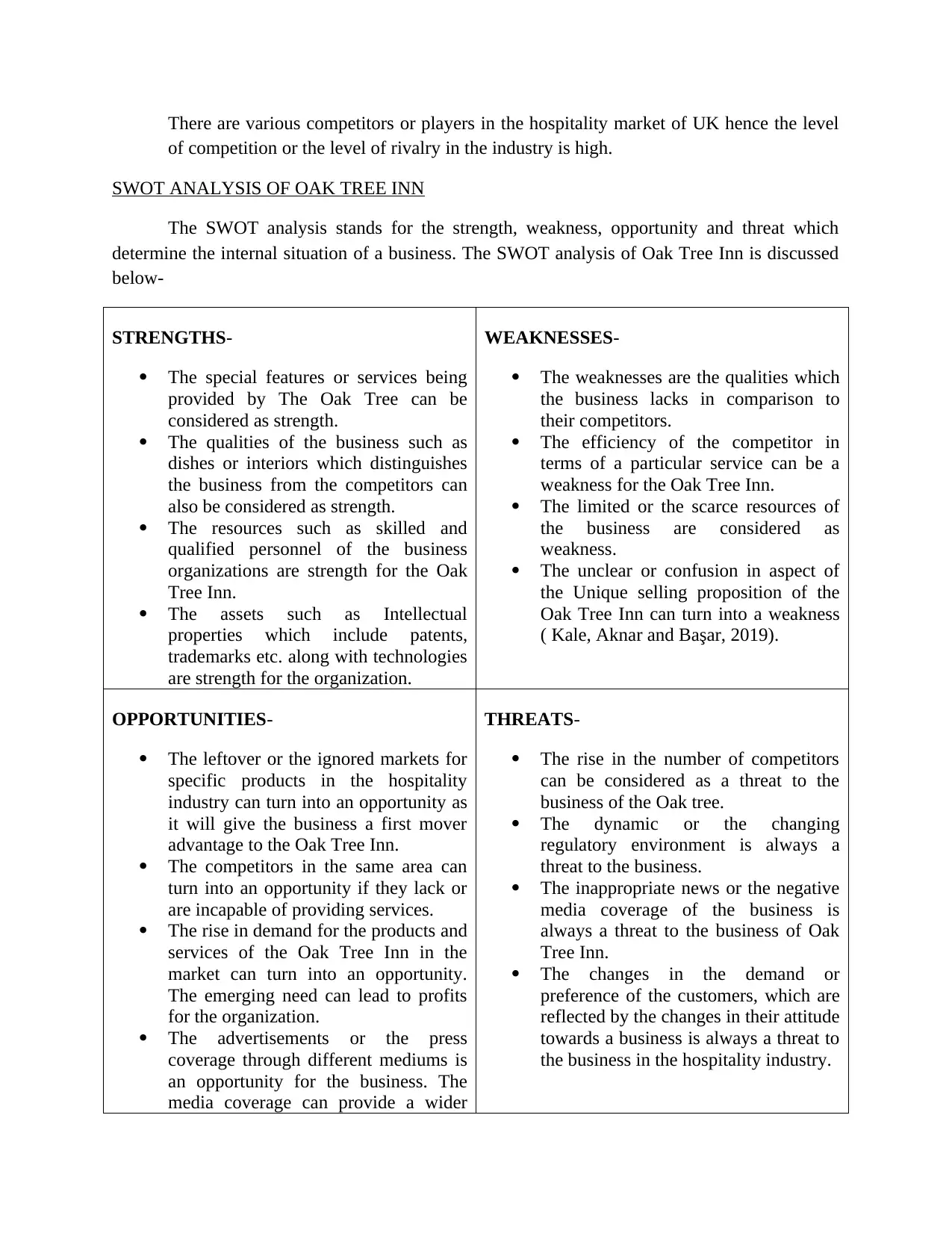
There are various competitors or players in the hospitality market of UK hence the level
of competition or the level of rivalry in the industry is high.
SWOT ANALYSIS OF OAK TREE INN
The SWOT analysis stands for the strength, weakness, opportunity and threat which
determine the internal situation of a business. The SWOT analysis of Oak Tree Inn is discussed
below-
STRENGTHS-
The special features or services being
provided by The Oak Tree can be
considered as strength.
The qualities of the business such as
dishes or interiors which distinguishes
the business from the competitors can
also be considered as strength.
The resources such as skilled and
qualified personnel of the business
organizations are strength for the Oak
Tree Inn.
The assets such as Intellectual
properties which include patents,
trademarks etc. along with technologies
are strength for the organization.
WEAKNESSES-
The weaknesses are the qualities which
the business lacks in comparison to
their competitors.
The efficiency of the competitor in
terms of a particular service can be a
weakness for the Oak Tree Inn.
The limited or the scarce resources of
the business are considered as
weakness.
The unclear or confusion in aspect of
the Unique selling proposition of the
Oak Tree Inn can turn into a weakness
( Kale, Aknar and Başar, 2019).
OPPORTUNITIES-
The leftover or the ignored markets for
specific products in the hospitality
industry can turn into an opportunity as
it will give the business a first mover
advantage to the Oak Tree Inn.
The competitors in the same area can
turn into an opportunity if they lack or
are incapable of providing services.
The rise in demand for the products and
services of the Oak Tree Inn in the
market can turn into an opportunity.
The emerging need can lead to profits
for the organization.
The advertisements or the press
coverage through different mediums is
an opportunity for the business. The
media coverage can provide a wider
THREATS-
The rise in the number of competitors
can be considered as a threat to the
business of the Oak tree.
The dynamic or the changing
regulatory environment is always a
threat to the business.
The inappropriate news or the negative
media coverage of the business is
always a threat to the business of Oak
Tree Inn.
The changes in the demand or
preference of the customers, which are
reflected by the changes in their attitude
towards a business is always a threat to
the business in the hospitality industry.
of competition or the level of rivalry in the industry is high.
SWOT ANALYSIS OF OAK TREE INN
The SWOT analysis stands for the strength, weakness, opportunity and threat which
determine the internal situation of a business. The SWOT analysis of Oak Tree Inn is discussed
below-
STRENGTHS-
The special features or services being
provided by The Oak Tree can be
considered as strength.
The qualities of the business such as
dishes or interiors which distinguishes
the business from the competitors can
also be considered as strength.
The resources such as skilled and
qualified personnel of the business
organizations are strength for the Oak
Tree Inn.
The assets such as Intellectual
properties which include patents,
trademarks etc. along with technologies
are strength for the organization.
WEAKNESSES-
The weaknesses are the qualities which
the business lacks in comparison to
their competitors.
The efficiency of the competitor in
terms of a particular service can be a
weakness for the Oak Tree Inn.
The limited or the scarce resources of
the business are considered as
weakness.
The unclear or confusion in aspect of
the Unique selling proposition of the
Oak Tree Inn can turn into a weakness
( Kale, Aknar and Başar, 2019).
OPPORTUNITIES-
The leftover or the ignored markets for
specific products in the hospitality
industry can turn into an opportunity as
it will give the business a first mover
advantage to the Oak Tree Inn.
The competitors in the same area can
turn into an opportunity if they lack or
are incapable of providing services.
The rise in demand for the products and
services of the Oak Tree Inn in the
market can turn into an opportunity.
The emerging need can lead to profits
for the organization.
The advertisements or the press
coverage through different mediums is
an opportunity for the business. The
media coverage can provide a wider
THREATS-
The rise in the number of competitors
can be considered as a threat to the
business of the Oak tree.
The dynamic or the changing
regulatory environment is always a
threat to the business.
The inappropriate news or the negative
media coverage of the business is
always a threat to the business of Oak
Tree Inn.
The changes in the demand or
preference of the customers, which are
reflected by the changes in their attitude
towards a business is always a threat to
the business in the hospitality industry.
Paraphrase This Document
Need a fresh take? Get an instant paraphrase of this document with our AI Paraphraser
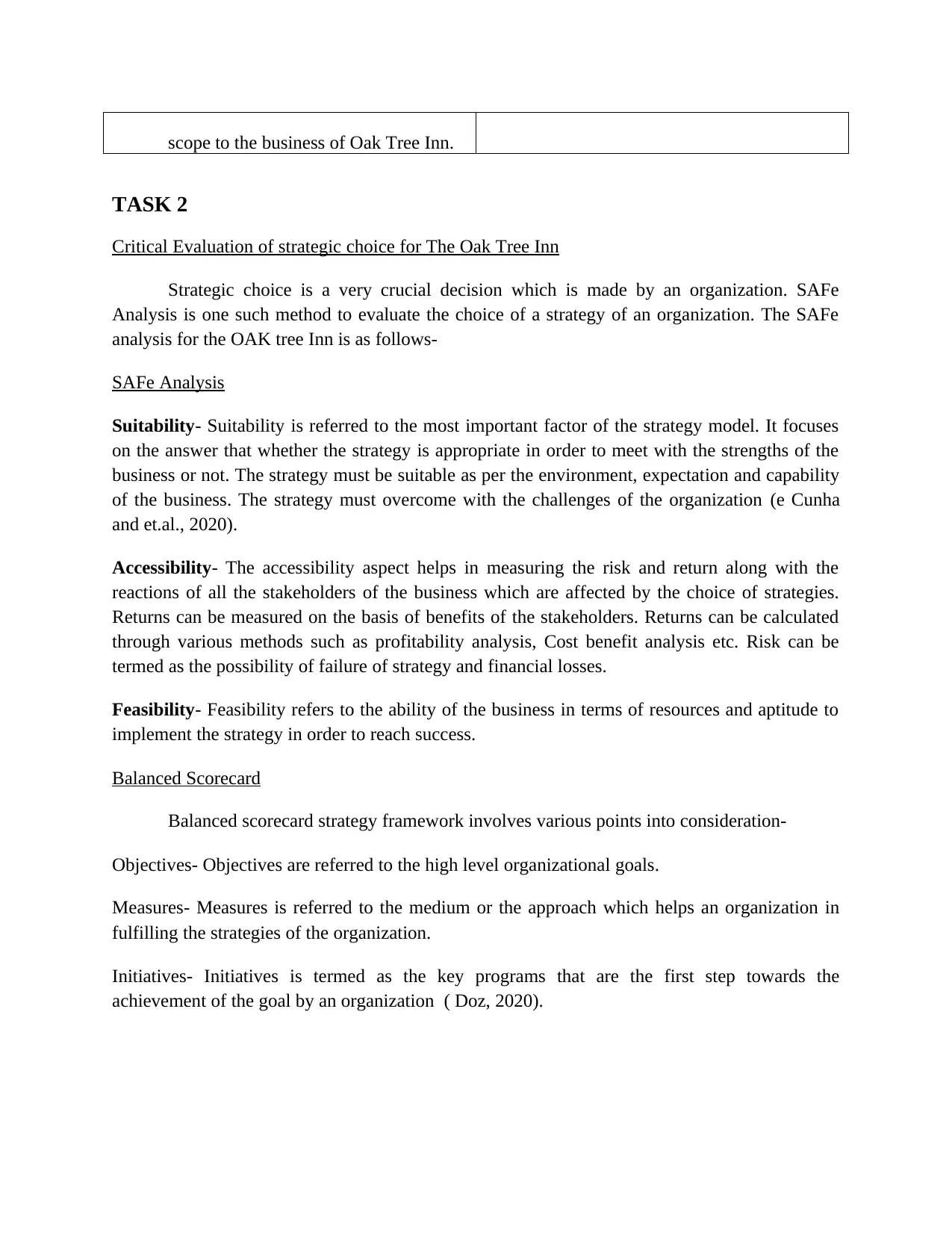
scope to the business of Oak Tree Inn.
TASK 2
Critical Evaluation of strategic choice for The Oak Tree Inn
Strategic choice is a very crucial decision which is made by an organization. SAFe
Analysis is one such method to evaluate the choice of a strategy of an organization. The SAFe
analysis for the OAK tree Inn is as follows-
SAFe Analysis
Suitability- Suitability is referred to the most important factor of the strategy model. It focuses
on the answer that whether the strategy is appropriate in order to meet with the strengths of the
business or not. The strategy must be suitable as per the environment, expectation and capability
of the business. The strategy must overcome with the challenges of the organization (e Cunha
and et.al., 2020).
Accessibility- The accessibility aspect helps in measuring the risk and return along with the
reactions of all the stakeholders of the business which are affected by the choice of strategies.
Returns can be measured on the basis of benefits of the stakeholders. Returns can be calculated
through various methods such as profitability analysis, Cost benefit analysis etc. Risk can be
termed as the possibility of failure of strategy and financial losses.
Feasibility- Feasibility refers to the ability of the business in terms of resources and aptitude to
implement the strategy in order to reach success.
Balanced Scorecard
Balanced scorecard strategy framework involves various points into consideration-
Objectives- Objectives are referred to the high level organizational goals.
Measures- Measures is referred to the medium or the approach which helps an organization in
fulfilling the strategies of the organization.
Initiatives- Initiatives is termed as the key programs that are the first step towards the
achievement of the goal by an organization ( Doz, 2020).
TASK 2
Critical Evaluation of strategic choice for The Oak Tree Inn
Strategic choice is a very crucial decision which is made by an organization. SAFe
Analysis is one such method to evaluate the choice of a strategy of an organization. The SAFe
analysis for the OAK tree Inn is as follows-
SAFe Analysis
Suitability- Suitability is referred to the most important factor of the strategy model. It focuses
on the answer that whether the strategy is appropriate in order to meet with the strengths of the
business or not. The strategy must be suitable as per the environment, expectation and capability
of the business. The strategy must overcome with the challenges of the organization (e Cunha
and et.al., 2020).
Accessibility- The accessibility aspect helps in measuring the risk and return along with the
reactions of all the stakeholders of the business which are affected by the choice of strategies.
Returns can be measured on the basis of benefits of the stakeholders. Returns can be calculated
through various methods such as profitability analysis, Cost benefit analysis etc. Risk can be
termed as the possibility of failure of strategy and financial losses.
Feasibility- Feasibility refers to the ability of the business in terms of resources and aptitude to
implement the strategy in order to reach success.
Balanced Scorecard
Balanced scorecard strategy framework involves various points into consideration-
Objectives- Objectives are referred to the high level organizational goals.
Measures- Measures is referred to the medium or the approach which helps an organization in
fulfilling the strategies of the organization.
Initiatives- Initiatives is termed as the key programs that are the first step towards the
achievement of the goal by an organization ( Doz, 2020).
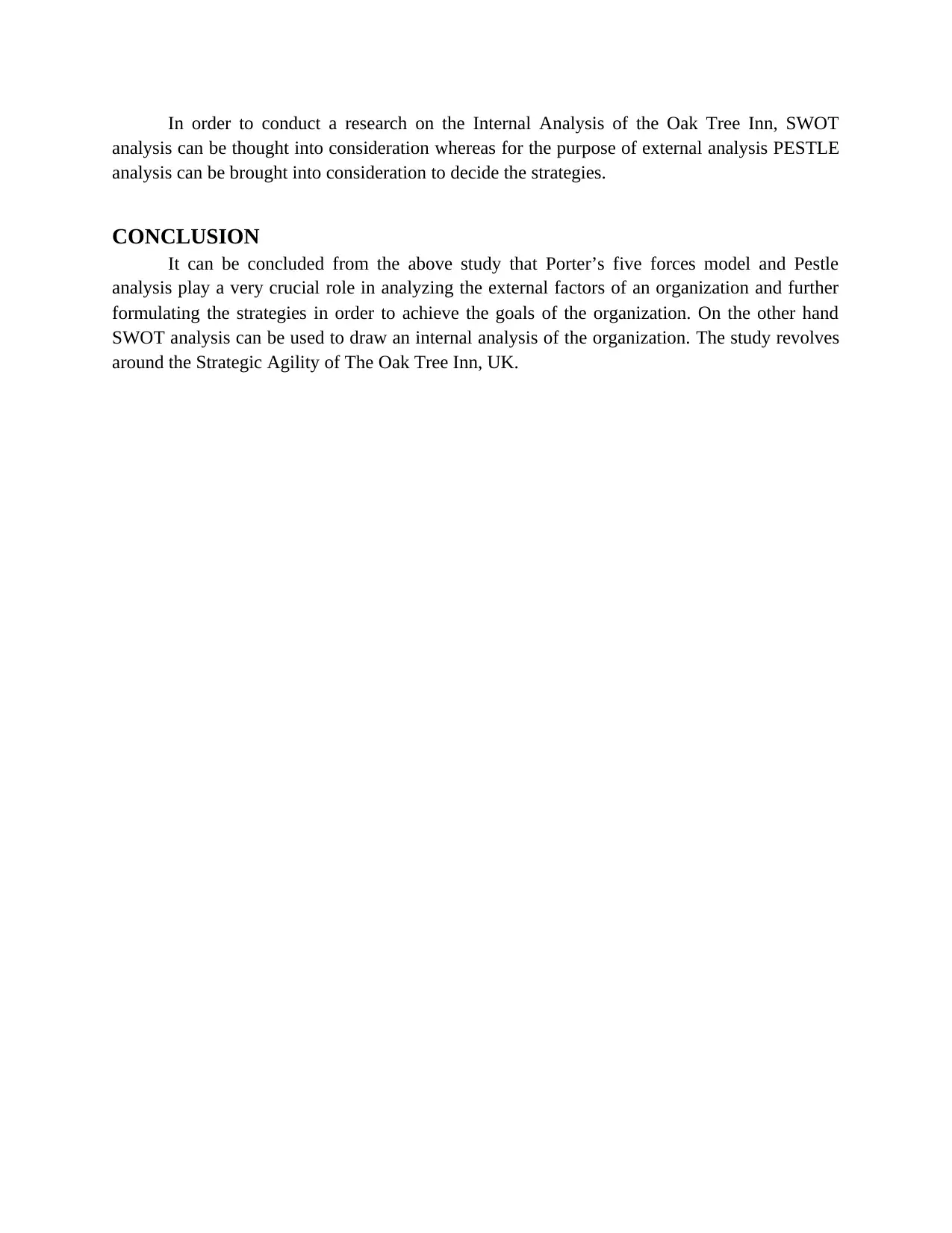
In order to conduct a research on the Internal Analysis of the Oak Tree Inn, SWOT
analysis can be thought into consideration whereas for the purpose of external analysis PESTLE
analysis can be brought into consideration to decide the strategies.
CONCLUSION
It can be concluded from the above study that Porter’s five forces model and Pestle
analysis play a very crucial role in analyzing the external factors of an organization and further
formulating the strategies in order to achieve the goals of the organization. On the other hand
SWOT analysis can be used to draw an internal analysis of the organization. The study revolves
around the Strategic Agility of The Oak Tree Inn, UK.
analysis can be thought into consideration whereas for the purpose of external analysis PESTLE
analysis can be brought into consideration to decide the strategies.
CONCLUSION
It can be concluded from the above study that Porter’s five forces model and Pestle
analysis play a very crucial role in analyzing the external factors of an organization and further
formulating the strategies in order to achieve the goals of the organization. On the other hand
SWOT analysis can be used to draw an internal analysis of the organization. The study revolves
around the Strategic Agility of The Oak Tree Inn, UK.
⊘ This is a preview!⊘
Do you want full access?
Subscribe today to unlock all pages.

Trusted by 1+ million students worldwide
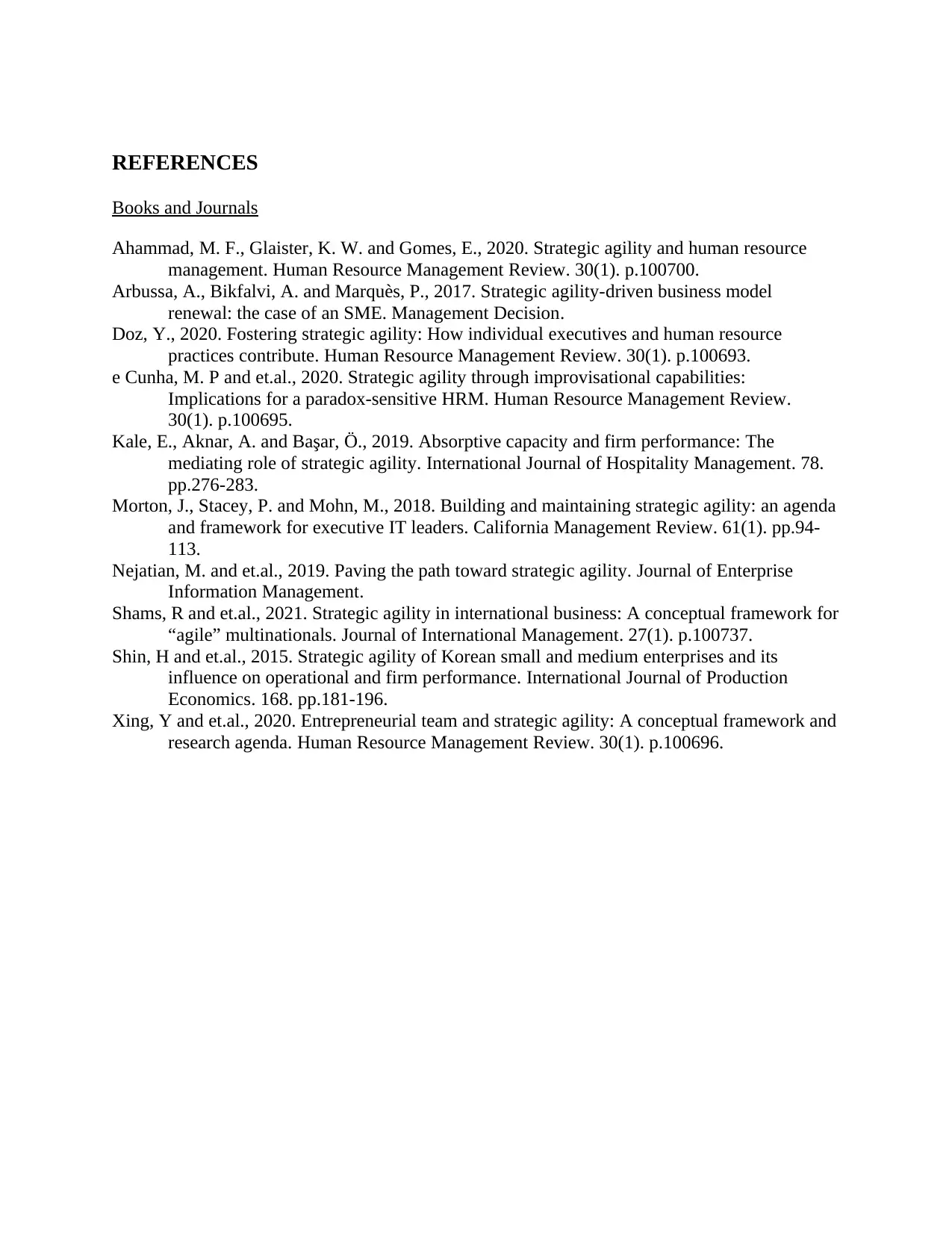
REFERENCES
Books and Journals
Ahammad, M. F., Glaister, K. W. and Gomes, E., 2020. Strategic agility and human resource
management. Human Resource Management Review. 30(1). p.100700.
Arbussa, A., Bikfalvi, A. and Marquès, P., 2017. Strategic agility-driven business model
renewal: the case of an SME. Management Decision.
Doz, Y., 2020. Fostering strategic agility: How individual executives and human resource
practices contribute. Human Resource Management Review. 30(1). p.100693.
e Cunha, M. P and et.al., 2020. Strategic agility through improvisational capabilities:
Implications for a paradox-sensitive HRM. Human Resource Management Review.
30(1). p.100695.
Kale, E., Aknar, A. and Başar, Ö., 2019. Absorptive capacity and firm performance: The
mediating role of strategic agility. International Journal of Hospitality Management. 78.
pp.276-283.
Morton, J., Stacey, P. and Mohn, M., 2018. Building and maintaining strategic agility: an agenda
and framework for executive IT leaders. California Management Review. 61(1). pp.94-
113.
Nejatian, M. and et.al., 2019. Paving the path toward strategic agility. Journal of Enterprise
Information Management.
Shams, R and et.al., 2021. Strategic agility in international business: A conceptual framework for
“agile” multinationals. Journal of International Management. 27(1). p.100737.
Shin, H and et.al., 2015. Strategic agility of Korean small and medium enterprises and its
influence on operational and firm performance. International Journal of Production
Economics. 168. pp.181-196.
Xing, Y and et.al., 2020. Entrepreneurial team and strategic agility: A conceptual framework and
research agenda. Human Resource Management Review. 30(1). p.100696.
Books and Journals
Ahammad, M. F., Glaister, K. W. and Gomes, E., 2020. Strategic agility and human resource
management. Human Resource Management Review. 30(1). p.100700.
Arbussa, A., Bikfalvi, A. and Marquès, P., 2017. Strategic agility-driven business model
renewal: the case of an SME. Management Decision.
Doz, Y., 2020. Fostering strategic agility: How individual executives and human resource
practices contribute. Human Resource Management Review. 30(1). p.100693.
e Cunha, M. P and et.al., 2020. Strategic agility through improvisational capabilities:
Implications for a paradox-sensitive HRM. Human Resource Management Review.
30(1). p.100695.
Kale, E., Aknar, A. and Başar, Ö., 2019. Absorptive capacity and firm performance: The
mediating role of strategic agility. International Journal of Hospitality Management. 78.
pp.276-283.
Morton, J., Stacey, P. and Mohn, M., 2018. Building and maintaining strategic agility: an agenda
and framework for executive IT leaders. California Management Review. 61(1). pp.94-
113.
Nejatian, M. and et.al., 2019. Paving the path toward strategic agility. Journal of Enterprise
Information Management.
Shams, R and et.al., 2021. Strategic agility in international business: A conceptual framework for
“agile” multinationals. Journal of International Management. 27(1). p.100737.
Shin, H and et.al., 2015. Strategic agility of Korean small and medium enterprises and its
influence on operational and firm performance. International Journal of Production
Economics. 168. pp.181-196.
Xing, Y and et.al., 2020. Entrepreneurial team and strategic agility: A conceptual framework and
research agenda. Human Resource Management Review. 30(1). p.100696.
1 out of 10
Related Documents
Your All-in-One AI-Powered Toolkit for Academic Success.
+13062052269
info@desklib.com
Available 24*7 on WhatsApp / Email
![[object Object]](/_next/static/media/star-bottom.7253800d.svg)
Unlock your academic potential
Copyright © 2020–2025 A2Z Services. All Rights Reserved. Developed and managed by ZUCOL.



